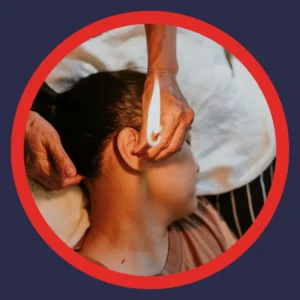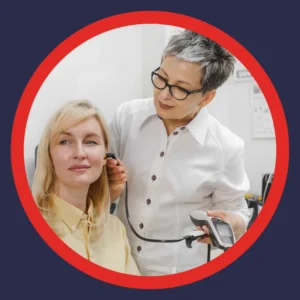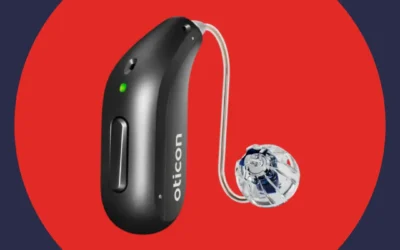When cold or flu symptoms strike, it’s common to feel like your ears are clogged. Congestion can cause pressure in the sinuses and Eustachian tubes, making it seem as if earwax is building up. In the search for relief, many people turn to “natural” fixes like ear candling, but this one should never make your list.
Ear candling is often promoted as a quick way to “draw out” wax and ease fullness. The truth is that it doesn’t remove earwax or relieve pressure, and it can easily cause burns, blockages, or eardrum injuries. There’s also no evidence that it creates any suction at all. In fact, the FDA warns that ear candling is ineffective and risky.
People of all ages, including kids, adults, and seniors, can injure their ears with this method, especially when already fighting colds, sinus infections, or flu congestion. Ear candling is unsafe in every season and for every ear.
Common reasons people try ear candling during cold and flu season:
- Feeling fullness or pressure in one or both ears
- Believing that earwax causes hearing changes
- Seeking quick “detox” or “natural” relief from congestion
Ear fullness during illness usually comes from fluid or inflammation, not earwax. Understanding what ear candling actually is and why it fails to help is the next step toward safer ear care.

What Exactly Is Ear Candling?
Ear candling, also known as ear coning or thermal-auricular therapy, involves placing a hollow waxed tube into the ear canal and lighting the exposed end. The idea is that the flame creates a vacuum that pulls out earwax, fluid, or “toxins.” It sounds soothing, but the process doesn’t actually remove anything except your sense of safety.
Research has repeatedly disproven the suction theory. A clinical study in The Laryngoscope found that ear candles do not produce negative pressure or remove earwax. Instead, melted candle wax often drips into the ear canal, worsening blockages. What people see inside the burned candle afterward isn’t earwax—it’s residue from the candle itself.
Myths vs. Facts About Ear Candling
- Myth: Ear candling removes earwax.
Fact: No suction is created, and wax can be pushed deeper instead. - Myth: It helps relieve sinus pressure or improves hearing.
Fact: Studies show no medical benefit. - Myth: It’s safe if you’re careful.
Fact: Even with assistance, burns and injuries are common. - Myth: It’s a natural wellness ritual.
Fact: Nature never intended you to set your ears on fire.
Ear candling might sound relaxing, but the risks are real. The next section explains exactly how this practice can damage your ears.
The Proven Dangers of Ear Candling
The biggest problem with ear candling isn’t that it fails to work—it’s that it can seriously hurt you. Medical studies have found burns, blocked ear canals, punctured eardrums, and even house fires linked to this practice. In one clinical survey, 21 ear injuries were reported from candle use, and those were only the ones seen by otolaryngologists.
Lighting a flame near your head is risky enough. Add melting wax dripping into your ear canal, and you have a recipe for damage. These injuries aren’t rare accidents—they’re common consequences of an unsafe method that has no proven benefit.
Common Risks Linked to Ear Candling:
- Burns: Hot wax and open flame can burn the ear, scalp, or hair.
- Punctured Eardrum: The cone can push or puncture the eardrum.
- Earwax Blockage: Melted wax can harden and trap existing wax deeper.
- Infection: Residue left in the canal can irritate tissue and invite bacteria.
- Fire Hazard: Several home fires have started during attempted ear candling.
Medical experts agree that ear candling is ineffective and unsafe. The good news is that there are proven, gentle ways to clean your ears and restore comfort without risk.
Why You Should Never DIY Earwax Removal When You’re Sick
When you’re fighting a cold, sinus infection, or the flu, your ears can feel plugged or full. That sensation doesn’t usually mean earwax buildup—it’s often caused by congestion or swelling that affects the Eustachian tubes. Trying to fix it yourself can do more harm than good.
During illness, your ear canal and sinuses are more sensitive and prone to irritation. Using tools or candles to “clear” the blockage can scratch the skin or push wax deeper. Instead, focus on staying hydrated, using a humidifier, and letting your body recover. If symptoms persist, a professional can safely check your ears and confirm what’s really going on.
Common DIY Mistakes That Can Make Ear Problems Worse:
- Using cotton swabs or hairpins to dig out wax
- Trying ear candling as a quick fix
- Using homemade suction or “vacuum” tools
- Pouring alcohol, oil, or peroxide mixtures without guidance
Your ears are designed to clean themselves. When they need a little help, there are safe, effective ways to do it. Learn more in Understanding How to Reduce Ear Wax.
When in doubt, skip the candles and the cotton swabs. Your ears will thank you—and stay much healthier in the process.
Safer Alternatives to Remove Earwax
The good news is that safe earwax removal doesn’t require candles, flames, or risky tricks. Whether you’re dealing with earwax buildup or just want to keep your ears clear, there are proven, gentle ways to do it.
Audiologists and primary care providers use tools and techniques designed to protect the delicate ear canal. You can also support natural wax removal at home with warm water, softening drops, and patience. The key is knowing what’s safe and what’s not.
Unsafe vs. Safe Ear Cleaning Methods
|
Unsafe Method |
Why It’s Harmful |
Safe Alternative |
Why It Works |
|
Ear Candling |
Can cause burns and injuries |
Professional Ear Cleaning |
Done with magnification and medical instruments |
|
Cotton Swabs |
Push wax deeper into the canal |
OTC Ear Drops |
Soften wax for gentle removal |
|
Sharp Objects |
Risk of puncture or irritation |
Warm Shower Water |
Helps loosen wax naturally |
|
Home “Vacuum” Devices |
Unregulated and risky |
Medical Ear Irrigation |
Uses safe, sterile equipment |
Even though DIY tools may sound harmless, they can quickly turn painful. Professional ear care ensures your ear canal stays healthy and free from damage. Learn more about Professional Ear Wax Removal—Is It Right for You? and find a nearby clinic through Where to Get Ear Wax Removal Near Me.
Leave suction power to your household vacuum, not your ear canal. The safest results always come from trained professionals.
When to Seek Professional Help
Most of the time, your ears take care of themselves. But when earwax becomes impacted or symptoms linger, professional help is the safest choice. Ear candling, cotton swabs, and over-the-counter “ear vacuums” can’t replace expert care—and they often make things worse.
Audiologists use specialized tools and magnification to safely remove wax without harming the ear canal or eardrum. They can also check your hearing and ensure that discomfort isn’t linked to another issue such as infection or fluid buildup.
You Should Schedule a Professional Ear Exam If You Notice:
- Muffled or reduced hearing
- Ear pain or a feeling of fullness
- Ringing or buzzing in one or both ears
- Dizziness, imbalance, or pressure changes
- Persistent wax that doesn’t clear with drops
If hearing loss is part of the problem, professional evaluation matters even more. Learn practical ways to manage your hearing and communication in Bilateral Hearing Loss: How to Manage Yours.
Getting your ears checked regularly is simple, comfortable, and far safer than any candle or cotton swab could ever be.
Hearing Aid Users and Earwax: What to Know
Hearing aids make hearing easier, but they can also make earwax management a little trickier. Because the device rests inside or around the ear canal, it can block the ear’s natural process of pushing wax outward. That means wax may collect faster, leading to muffled sound or even device malfunction.
During cold and flu season, ear care becomes even more important. Sinus congestion, coughing, and excess mucus can increase moisture in the ear canal. That trapped humidity can affect both your hearing aids and your ear health if you’re not careful.
Why Hearing Aids Can Lead to Earwax Buildup
- The device partially seals the ear canal, slowing natural wax movement.
- Hearing aid use can stimulate glands that produce more earwax.
- Trapped wax can block microphones or receivers, causing feedback or weak sound.
- Attempting to clean wax at home with sharp tools or cotton swabs can push it deeper.
Safe Ear Care Tips for Hearing Aid Users
|
Do This |
Why It Helps |
|
Wipe hearing aids daily with a soft, dry cloth |
Removes moisture and prevents wax buildup |
|
Replace wax guards and domes as instructed |
Keeps the receiver clear and sound quality sharp |
|
Schedule professional cleanings every few months |
Removes wax safely and prevents ear irritation |
|
Store hearing aids in a drying case overnight |
Reduces moisture that can harden earwax |
|
Avoid inserting objects into your ear canal |
Protects the eardrum and prevents wax impaction |
Extra Precautions During Flu Season
- Keep ears dry: Moisture from steam or humidifiers can encourage wax buildup.
- Clean devices more often: Wipe hearing aids after every use to remove moisture from sneezing or coughing.
- Avoid sharing earbuds or hearing aid accessories: Germs spread easily this time of year.
- Watch for fullness or pressure: Congestion can mimic earwax blockage, so get checked if symptoms persist.
- Rest and hydrate: Proper hydration helps thin mucus and supports natural ear drainage.
If you notice muffled hearing or feedback, remove your hearing aids and check for visible wax. If the issue continues, your audiologist can inspect both your ears and your devices under magnification.
Consistent cleaning, seasonal awareness, and routine ear checks help protect your hearing aids and keep your ears healthy year-round.
Good Ear Hygiene Habits for Cold and Flu Season
Cold and flu season can take a toll on your ears. Congestion, sneezing, and frequent nose blowing can all affect pressure in your ear canal and Eustachian tubes. Protecting your ears this time of year isn’t complicated—it’s mostly about keeping things clean, dry, and balanced.
Good ear hygiene supports healthy hearing and helps prevent wax buildup or infection. Even small habits, when done consistently, can make a big difference.

Healthy Ear Care Habits for the Season
|
Habit |
Why It Matters |
|
Keep ears dry after showers or humid weather |
Prevents bacterial growth and moisture buildup |
|
Avoid inserting cotton swabs or objects into the ear canal |
Reduces injury and wax impaction |
|
Use a humidifier wisely |
Keeps nasal passages moist without over-humidifying the ears |
|
Stay hydrated and manage congestion |
Helps Eustachian tubes drain properly |
|
Clean hearing aids and earbuds regularly |
Prevents bacteria transfer and improves sound clarity |
|
Wash hands often |
Limits germs that can lead to ear or sinus infections |
|
Schedule a professional ear check if discomfort continues |
Ensures safe, effective wax removal when needed |
Maintaining these simple routines keeps your ears clear, comfortable, and infection-free. It’s also a great time to focus on overall hearing health. Explore Celebrate National Protect Your Hearing Month to learn more about everyday hearing care.
Taking care of your ears during flu season isn’t about doing more—it’s about doing it smarter. Next, we’ll wrap up with a few common questions about ear candling and safe ear care.

The Takeaway: Keep Flames Away From Your Ears
Ear candling may look relaxing, but it’s neither safe nor effective. It doesn’t remove earwax or relieve pressure—and it can lead to burns, blockages, and lasting ear damage. Your ears are self-cleaning and only need help when wax builds up or hearing feels muffled.
Safe ear care starts with science, not smoke. If you’re experiencing discomfort, fullness, or hearing changes this season, skip the candles and get professional help instead. The hearing specialists at American Hearing + Audiology can safely remove earwax and check your hearing at no cost.
Call your nearest American Hearing + Audiology location to schedule your free hearing test and keep your ears healthy all year long.
FAQs About Ear Candling and Ear Care
- Does ear candling actually remove earwax?
No. Studies show that ear candling doesn’t create suction or remove earwax. It only leaves candle residue, which can worsen blockages. - Is ear candling ever safe for kids or seniors?
No. Ear candling is unsafe for all ages and can easily cause burns or injury. Children and older adults are especially at risk because their ear canals are more delicate. - How can I tell if my ears are clogged with wax or fluid?
Wax buildup causes gradual muffled hearing, while congestion or infection causes pressure and fullness. Only a professional exam can confirm which is which. - What’s the safest way to clean my ears at home?
You can use soft cloths or over-the-counter drops that soften earwax. Avoid inserting any object into the ear canal. - Can I combine ear drops and irrigation?
Only if your provider recommends it. Drops can loosen wax first, and irrigation can gently flush it out—but both should be done carefully. - How often should I have my ears checked?
At least once a year, or sooner if you wear hearing aids, use earbuds frequently, or experience ear discomfort.
Ear health is simple when you stick with safe, science-backed care. In the final section, we’ll wrap up with a quick reminder to keep flames far away from your ears.



